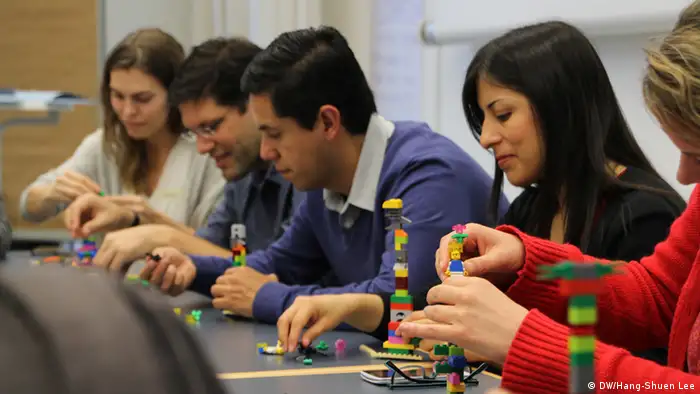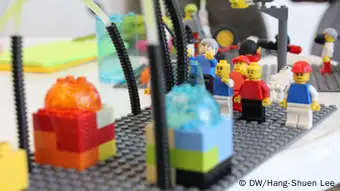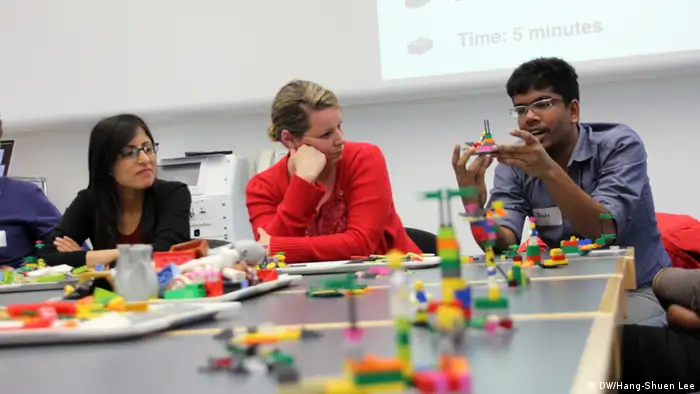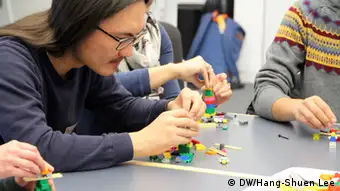DW AKADEMIE
Bonn: Freedom of expression with Lego and design thinking
Building blocks and Post-it notes can change the world - or at least help develop new ideas. At a South2South workshop, creative minds from three continents looked at ways digital technologies can improve people's lives.
Colorful plastic blocks, stocky yellow figures and teetering towers: for many of us, Lego bricks bring back childhood memories. Although playing with Lego can simply be for fun, it can also trigger new thought processes. This was the case at DW Akademie's South2South Lab held December 14 - 16, 2015 in Bonn.
For three days, twenty journalists and media experts from across the world worked together to develop new ideas for using digital technology to foster freedom of expression and information.
The Lab was based on the South2South Manifesto that some of those attending had formulated during a media dialogue held in Cape Town at the end of 2014. The manifesto is centered around seven principles for the promotion of freedom of expression, including sustainability, participation and knowledge transfer.
Participants of the Bonn workshop built on this as a foundation - in the literal sense of the word. Their goal here was not just to exchange ideas, but to put them into practice using Lego bricks. DW Akademie trainer Guy Degen is well versed in the methods of "Lego Serious Play".
The participants split in to groups and under Degen's guidance built structures reflecting their interpretation of freedom of expression. Some pieced together translucent bricks to demonstrate transparency; others attached tubes to the heads of Lego figures to illustrate the free exchange of information. "There is a close connection between what we are doing with our hands and what is going on in our minds," explains Degen.
Diversity generates ideas
In addition to Lego, the workshop also focused on design thinking. "Our concept is based on mixing creative methods like these," says project manager Steffen Leidel, who developed the South2South Lab together with Attila Mong. "Our aim is to develop digital concepts that relate to freedom of expression, and that are based on the needs and motivation of people in the Global South."
Another key element in the project, Leidel says, is that participants not only come from different countries and cultures, but that they bring with them different sets of skills. At the workshop, journalists from Peru and Germany worked with software developers from Myanmar and Uganda, and media executives from the Palestinian territories collaborated with designers from South Africa.
At the end of the third day the groups presented their ideas in the form of prototypes: a clickable interface, for example, or a programmed tool that roughly showed what an app or website could look like.
Sahar Habib Ghazi is the managing editor of Global Voices, a platform for articles written by citizens around the world. At the workshop, her group focused on how events in the Global South could receive the same type of media attention as, for example, the Charlie Hebdo attack in Paris. She says for her, the digital aspect of the Lab was crucial: "When it comes to freedom of expression, it's not only what you say that's important - it's also what you're thinking." Although ideas were once bound by geographical borders, she adds, with digital technologies we are now able to go far beyond them.
Prototypes for media freedoms
One of the Lab groups looked at how to help a rural farmer take better advantage of public services. They based their ideas on a concrete example, analyzing the life and routines of one of the participants' uncles.
Another team focused on developing a news app for Palestinian youths aged between 13 and 18. Although young people with smartphones can access news targeted specifically at their age group, with the news app they would be able to easily produce news themselves, using video, audio and text elements.
Alhareth Rayyan works for the NGO PalVision, a multimedia platform focusing on the concerns of young Palestinians in East Jerusalem, and he was one of the workshop participants. His main interest is on youth and the media - and this was also the focus of the concept he and his group developed at the South2South Lab. He says when he arrived in Bonn, he had only one question in mind: what would come out of the South2South Lab? "Now I'm going home with even more questions," he says, "but I've also got many more ideas." This is also true for the other participants - and they leave the workshop with the hope that their ideas will help solve some of the problems facing people in the Global South.
DW recommends
WWW links
- Date 21.12.2015
- Author Marina Strauß / jw
- Print Print this page
- Permalink https://p.dw.com/p/1HRCP
- Date 21.12.2015
- Author Marina Strauß / jw
- Print Print this page
- Permalink https://p.dw.com/p/1HRCP




